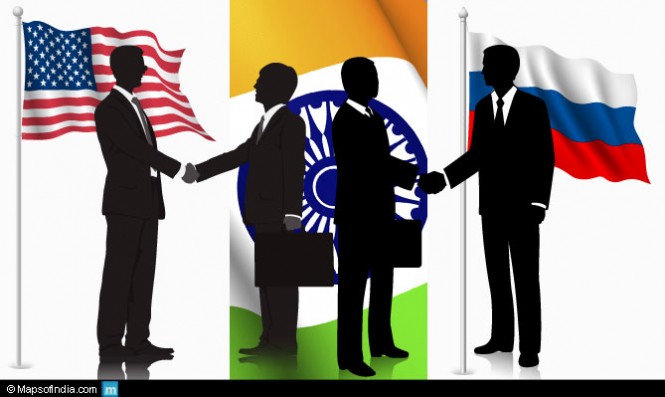 In Washington, when a few journalists recently asked White House spokesperson Marie Harf about Russian President Vladimir Putin’s India visit, her response was “Let’s wait and see what comes from the visit”. It indicated circumspection on the part of US authorities.
In Washington, when a few journalists recently asked White House spokesperson Marie Harf about Russian President Vladimir Putin’s India visit, her response was “Let’s wait and see what comes from the visit”. It indicated circumspection on the part of US authorities.
The fact remains that Russia is India’s most trusted partner. Understandably, Prime Minister Narendra Modi made it clear that Russia’s “uniqueness in India’s foreign policy will not change”. This position sharply goes against the US and the West’s position as they have imposed sanctions on Russia following the Ukrainian crisis. The signing of 20 agreements in the areas of defence, trade and commerce, nuclear, energy, space, education and others during Putin’s visit are pointers to further cementing of New Delhi’s ties with Moscow.
Following this, an impression has been created in the diplomatic corridors of the Western countries that Delhi is squandering an opportunity to build up stronger ties with US, whose President Barack Obama has accepted to become chief guest at India’s Republic Day celebrations.
Putin’s Visit not to Affect India-US Relations
Significantly, it is for the first time in history when a serving US President would attend the Republic Day function, and also the first US head of state who would be visiting India twice during his term. President Barack Obama had visited India in 2010. Western diplomats say this indicates America’s desire to consolidate its relations with India and as such Delhi should build it up. But foreign experts have different view. Their argument is that India’s engagement with the US or Russia is not at the cost of others and that its independence in foreign policy is beyond the influence of any oblique consideration.
Since 1963, Delhi purchased over $40 billion worth of defence equipment from Moscow and has agreed under ‘make in India brand’ to jointly manufacture Kamov226T light utility helicopters that can be used for both defence and civilian purposes. At least 400 choppers would be built in a year and would be meant for export also. During Putin’s visit, both the countries have increased the pace of negotiation for the futuristic fifth-generation fighter aircraft (FGFA) project, the bigger-ever defence programme for which India gave $295 million to Russia in December 2010 for preliminary design contract.
US Remains the Biggest Defence Supplier to India
Yet in the last one decade, it is the US that has emerged as the biggest supplier of defence products to India. As per data, the US has sold $10 billion worth of equipment to Delhi since 2004. Invariably, Delhi refuses to throw its lot with one or another nation in the multi-polar world. It is distinctly clear in the case of supply of nuclear reactors also. While the US and France have pressured India to take off its liability law before they could start selling their reactors to Delhi, Russia which has built Kudankulam nuclear Unit-I and Unit-II has signed contract for the third and the fourth reactors to be set up in Tamil Nadu. Moscow is not bothered about India’s liability law that envisages huge compensation by suppliers’ to host country in the event of nuclear accident. Instead, Moscow has shown readiness to supply at least 10 more nuclear reactors, with manufacturing of equipment and components done in India. It should be remembered that in the aftermath of May 1998, nuclear explosions, when Japan and the Western countries-led by the US imposed sanctions on Delhi and debarred it from getting nuclear material to fuel its reactors, Russia came out open with supplies of nuclear energy and technologies. Even as the bond of trust between the two countries has withstood the test of time, India and the US have pulled along amiably after the two countries signed the civil nuclear cooperation agreement in 2008. It created a watershed mark in the two countries engagement.
Yet in the post-Cold War era phase, the credit for laying the foundation for good relations between India and the US goes to the then US President Bill Clinton and then Prime Minister Atal Behari Vajpayee. During the just concluded US visit of Prime Minister Modi, the bilateral relations witnessed a significant growth with their joint vision statement endorsing their deep cooperation in every sector for the benefit of global stability. In defence, they agreed to build an enduring partnership and agreed for technology transfer, trade, research, co-production and co-development of high-end equipments. Then the two countries decided to renew for ten more years the 2005 Framework for India-US Defence Relationship. They agreed to reinvigorate the political-military dialogue and expanded its role to serve as a tool on the issue of export licensing, defence cooperation and strategic cooperation. They decided to expand military-to-military partnerships including expert exchanges, dialogues, and joint training and exercises. They also agreed to intensify cooperation in maritime security and upgrade their existing MALABAR series of bilateral exercise in the Indian Ocean.
India has Clear Strategic Goals
Experts say India has always pursued its foreign policy in accordance with its priorities and interests. In this background, there has been a fare share of differences between Delhi and its close partners too. Despite America’s direct and indirect pressure to support sanctions imposed on Moscow for the ongoing crisis in Ukraine, Delhi has maintained its independence. For this, there are reasons and that India can’t ignore them given its energy and security imperatives. Russia is not only a member of powerful UN Security Council, it is also going to serve Delhi’s interests in the South Asia region when the US and its allies have begun withdrawal of its troops from Afghanistan. Then in India’s quest for development, Russia is ready to pump in money for the Delhi-Mumbai Industrial Corridor, smart cities and freight corridors.
Clearly, India doesn’t want to pursue zero sum game policy either with Russia or America. This is seen by many as the complexity of India’s foreign policy. But Delhi is nonchalant in pursuance of its global roadmap by maintaining a strategic balance between Russia and the US in continuing its foreign engagement.
Read Also:
India’s foreign trade – Rising beyond mere relations
A long way to go for India
Modi Foreign Visits Map
Details of PM Modi’s Historic Visit to UAE
Expectations from Modi’s impending visit to Japan
Modi’s US visit
PM Modi’s Tour of Russia and Central Asia
Modi’s Three-nation Visit: China, Soth Korea & Mongolia
Indian Ocean Yatra
Modi Visit Boosts Indo-Nepal Relations
India Needs To Revive International Relations




